11 Rare George Washington Coins
Posted on — 2 CommentsGeorge Washington, America’s first president and one of its most revered founding fathers, left an indelible mark on the nation’s history. As a true American icon, it is no surprise that his image has graced countless American coins over the centuries. From vintage pieces to modern commemoratives, the rare George Washington coin remains among the most sought-after numismatic treasures. In this article, we’ll explore the history and significance of these coins, focusing on:
- The fascinating evolution of coins with George Washington on them
- The remarkable value of select specimens
- Where to find your own rare George Washington coin online
Watch this entertaining video to see a stunning Washington coin’s value revealed:
What coins are George Washington on?
From the iconic quarter in your pocket to rare commemorative pieces worth thousands, George Washington’s image appears on numerous U.S. coins. While not all Washington coins are considered rare or valuable, these are some of the most historically significant and sought-after specimens that collectors eagerly seek.
1. Rare George Washington dollar coin
The 2007 George Washington dollar coin kicked off the historic Presidential Dollar Series. Featuring a bold portrait of our first president on the obverse and the Statue of Liberty on the reverse – a design shared across the entire series – this manganese-brass coin marked a new chapter in American dollar coinage.
While the George Washington Dollar is not considered particularly rare due to its modern mintage, certain rare presidential dollar coins and error varieties can command significant premiums. Basic uncirculated specimens, however, remain readily available and affordable for beginning collectors.
George Washington Dollar
- Metal: Brass
- Year: 2007
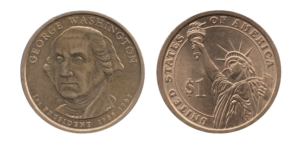
Photo by Numista
2. George Washington half dollar coin
This George Washington Half Dollar, otherwise known as the 1982 George Washington 250th anniversary coin, was issued to commemorate the 250th anniversary of Washington’s birth. This 90% silver commemorative coin features a striking right-facing portrait of Washington on horseback on the obverse, while the reverse displays Mount Vernon, his historic Virginia estate.
The design, crafted by Elizabeth Jones, was the first commemorative U.S. coin created in nearly three decades. Two versions were minted: an uncirculated version made in Denver and a proof version struck in San Francisco.
While not among the rarest Washington coins, high-grade specimens of this George Washington commemorative coin, particularly the proof versions, are increasingly coveted by collectors who appreciate their historical significance and superior craftsmanship.
George Washington Half Dollar
- Metal: Silver
- Year: 1982
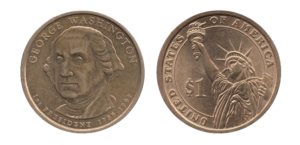
Photo by Numista
3. Rare Washington quarter coin
This 1959 rare Washington quarter coin represents a cherished piece from the historic 90% silver series that ran from 1932 to 1964. Originally introduced to commemorate Washington’s 200th birth anniversary, these quarters showcase John Flanagan’s elegant design featuring the first president’s left-facing portrait on the obverse. The reverse depicts a powerful American eagle perched on arrows and an olive branch, symbolizing national defense and peace.
While millions of these Washington quarter coins were produced for circulation, their 90% silver content makes them increasingly valuable today. The 1959 specimens are particularly interesting as they represent the latter years of silver quarter production, before the 1965 switch to copper-nickel cladding. Both collectors and precious metal investors value these coins not only for their silver content but also for their historical significance as pieces of everyday American commerce from a bygone era.
- Metal: Silver
- Year: 1959
- Check our most current price here.
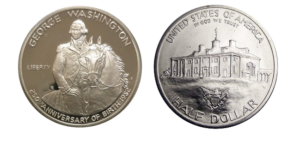
4. American Revolution bicentennial coin George Washington
The American Revolution Bicentennial George Washington Medal, also known as the George Washington Sons of Liberty coin, was minted in 1972 to commemorate the 200th anniversary of the American Revolution. The obverse of the medal features a detailed portrait of George Washington, while its reverse is adorned with a depiction of the Tree of Liberty, a powerful symbol of the American Revolution. The Tree of Liberty represents the resilience and freedom fought for during the war, echoing Thomas Jefferson’s famous quote about the need for liberty to be “refreshed from time to time with the blood of patriots and tyrants”.
Made of bronze, this medal is an important piece of exonumia. Although not rare, it holds historical significance and can be more valuable in higher grades or as part of a commemorative set from the Bicentennial.
American Revolution Bicentennial George Washington Medal
- Metal: Bronze
- Year: 1972
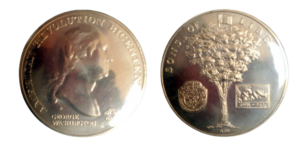
Photo by Numista
5. 1789 George Washington peace and friendship coin
Inspired by a historically significant design that dates back to the earliest days of American diplomacy, this coin has become a valued piece among collectors. The original peace medals were silver pieces given by George Washington to Native American leaders as symbols of friendship and diplomatic ties between the new United States and various tribes.
While not as rare as the original silver medals presented to tribal leaders, this 1904 bronze reproduction created by the U.S. Mint is more than a George Washington souvenir coin. It offers historians and collectors a meaningful connection to early American-Native American relations. Well-preserved pieces are particularly valued as early American diplomatic artifacts.
George Washington Indian Peace Medal
- Metal: Bronze
- Year: 1904
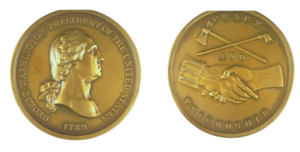
Photo by The National Museum of American History
6. George Washington 1st president coin
This brass token, created by the Scovill Manufacturing Company of Waterbury, Connecticut, honors George Washington’s legacy as the first president of the United States. Created during a period when commemorative tokens were popular promotional items, its obverse displays Washington’s bust, while the reverse features the titles “Father of His Country” and “American Fabius” along with the tribute: “FIRST IN WAR FIRST IN PEACE FIRST IN THE HEARTS OF HIS COUNTRYMEN SERVED EIGHT YEARS AS PRESIDENT WITHOUT PAY”.
Scovill, a pioneer in American industrial manufacturing, produced this token as part of a broader range of consumer goods, including buttons and political memorabilia. While not legal tender, these tokens were often distributed at celebrations, fairs, or historic events related to Washington’s legacy. Though not especially rare, this George Washington coin token is valued among collectors for its craftsmanship and connection to early American manufacturing and patriotism.
George Washington Commemorative Token
- Metal: Brass
- Year: Early 20th century
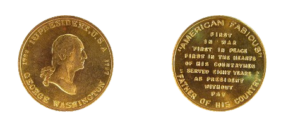
Photo by The National Museum of American History
7. 1797 George Washington Masonic coin
The 1797 Masonic coin with George Washington is one of the most intriguing pieces of early American medallic art, highlighting Washington’s connection to Freemasonry. This brass medal, struck during Washington’s lifetime, features his portrait on the obverse while incorporating distinctive Masonic symbols on the reverse – a testament to his role as a prominent Freemason.
While restrikes were made in later years, authentic 1797 specimens remain among the most desirable Washington medals, particularly appealing to collectors interested in both numismatics and Masonic history.
1797 Medal Washington Masonic
- Metal: Brass
- Year: 1797
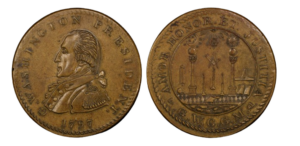
Photo by PCGS
8. George Washington Carver coin
The Washington – Carver Half Dollar, minted from 1951 to 1954, uniquely honors two great Americans: the U.S.A.’s first president George Washington, and agricultural scientist George Washington Carver. This commemorative silver half-dollar marks the first time an African American appeared on a U.S. coin, making it a groundbreaking piece in American numismatic history. The obverse features conjoined busts of both men, symbolizing the connection between American leadership and scientific innovation.
These coins were issued to promote racial cooperation and to fund research at the Tuskegee Institute, though sales fell short of expectations. Representing another historic instance of George Washington on a coin, well-preserved specimens hold special appeal for collectors interested in civil rights history and significant American commemoratives.
Washington – Carver Half Dollar
- Metal: Silver
- Year: 1951 – 1954
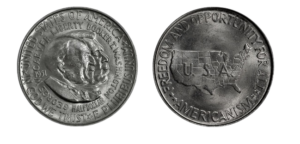
Photo by Numista
9. Washington crossing the Delaware coin
This 2021 Washington quarter coin pays homage to one of George Washington’s most iconic moments in the Revolutionary War. Made from copper-nickel, the coin’s reverse captures Washington standing at the bow of a boat, leading his troops across the icy Delaware River in 1776, a powerful symbol of bravery and determination. This design commemorates the bold action that helped turn the tide for American independence. On the obverse, Washington’s familiar profile remains, keeping continuity with the classic quarter design.
Though not considered particularly rare, this quarter marked a return to the single iconic image of Washington after years of diverse designs in the America the Beautiful series. Following the success of presidential coinage, like the John Adams presidential dollar, this design’s popularity with collectors shows the enduring appeal of our founding fathers on American coins.
Crossing the Delaware Washington Quarter
- Metal: Copper-nickel
- Year: 2021
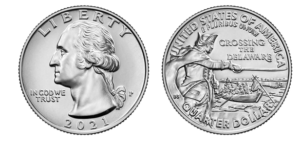
Photo by Numista
10. George Washington funeral coin
The 1800 Washington Funeral medal is one of the rarest and most significant George Washington gold coins ever created. Struck in the year following Washington’s death, these solemn commemorative medals were produced to honor the passing of America’s first president.
The design features a funeral urn with “GW” inscribed, symbolizing the nation’s mourning. Original specimens were likely presented to Washington family members and distinguished citizens during memorial services.
Given its early American origins, historical significance, and precious metal content, this funeral medal represents the pinnacle of Washington numismatic collecting. The few surviving authentic examples, when they appear at auction, command exceptional premiums and intense interest from serious collectors of early American medals.
AV Medal Washington Funeral, Urn
- Metal: Gold
- Year: 1800
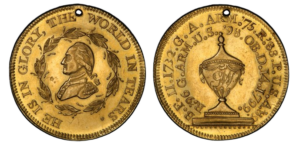
Photo by PCGS
11. 2007-W $10 Gold First Spouse CACG MS70 – Martha Washington
As the inaugural release in the First Spouse Gold Coin series, this $10 piece honors America’s first First Lady alongside her husband’s presidency. Minted at the West Point facility, coins graded MS70 by CACG, like the one below, represent the absolute pinnacle of mint perfection.
While the 1759 Martha Washington coin exists only as a rare test token created by the U.S. Mint for experimental purposes, this modern issue serves as an official tribute to her legacy. The coin’s obverse features a portrait of Martha Washington, while its reverse depicts her working with a seamstress in support of Revolutionary War soldiers.
Despite its modern mintage, perfect MS70 specimens of this historic first issue are increasingly valued by collectors, particularly those assembling complete First Spouse sets or specializing in presidential family commemoratives.
2007-W $10 Gold First Spouse CACG MS70 – Martha Washington
- Metal: Gold
- Year: 2007
- Get our most current price here.
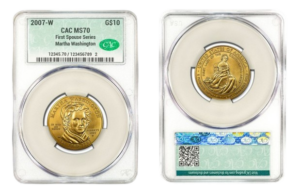
To browse through more rare pieces, beyond Washington coin specimens, click here.
Where to buy rare George Washington coins
The coins and medals featuring George Washington represent more than just currency. They are tangible pieces of American history, from historic silver issues to modern commemorative treasures. Each specimen tells its own unique story of our nation’s first president and his lasting impact on America.
Blanchard specializes in helping collectors acquire these historical pieces, and its expert team is always available to answer questions about George Washington rare coin specimens or assist in building your presidential collection. We invite you to explore these remarkable pieces of American heritage with us.
Want to read more? Subscribe to the Blanchard Newsletter and get our tales from the vault, our favorite stories from around the world and the latest tangible assets news delivered to your inbox weekly.
American CEOs Warn Higher Prices Ahead: That’s Good for Gold
Posted on — Leave a commentWant to buy a new laptop, smartphone or video game system? You might want to buy it now, because major American CEOs are warning that they are going to be raising prices soon. While this may be painful for American consumers—rising prices means more inflation—and that’s good for gold.

On the campaign trail, President-elect Donald Trump promised to enact a 10 to 20% tariff on imports from all foreign countries, and a 60 to 100% tariff on Chinese imports.
Tariffs are a tax on goods imported into the United States from foreign countries. The company that imports the goods into the United States is required to pay the tariff tax to the U.S. government.
Generally, companies are unwilling to take the hit on the tariff taxes they must pay to the U.S. government when they import these products. So they plan to pass those costs along to consumers in the form of higher prices. Here’s a snapshot of recent headlines:
Trump’s proposed tariffs would raise prices for these products—ABC News, Nov. 18
Tariffs Could Make Your Holiday Shopping Pricier in 2025—Kiplinger, Nov. 21
3 Major Retailers Who Will Raise Prices Immediately—Yahoo Finance, Nov. 22.
Best Buy says Trump’s tariffs could force it to raise prices –CBS News, Nov. 26
On recent earnings calls, three major U.S. retailers have already said their prices will go up. These include: Auto Zone, Columbia Sportswear and Stanley Black and Decker.
So how much could this actually cost American consumers?
The National Retail Federation did a study and here’s what they found: A 10% tariff on all imports and an additional 60% tariff on imports from China would boost the price of the average household appliance by 19.4%. That assumes that the retailers fully pass on the additional tariff cost to consumers. For example, that means the price of a basic refrigerator would rise from around $650 to $776.
Electronic price increases could be even more and that includes video game consoles, smartphones and even computers. A 10% across-the-board import tariff plus the additional 60% on Chinese goods could result in a 45% increase in the consumer prices for laptops and tablets, according to analysis from the Consumer Technology Association. On average, that means consumers would pay $357 more for laptops and $201 for tablets.
So, brace yourself, inflation isn’t going away anytime soon.
What does this mean for gold?
Earlier this year, gold soared past $2,700 in part due to ongoing inflation concerns. Gold has an inherently limited physical supply. Gold does not perish or degrade over time, and this all helps to make gold a strategic inflation hedge.
Since ancient times, gold has been used as a store of value and a form or currency and today provides even more value to investors. Compared to other modern forms of investment, gold holds a significant advantage—as gold has no default risk.
Gold has a proven track record in protecting purchasing power over the long run, which is a major reason investors have been flocking to the precious metal in 2024. Analysts predict gold could hit $3,000 in 2025 as inflation ramps up even more. The time is right to add gold to your portfolio before it climbs even more. Don’t wait too long, higher prices are just around the corner.
Want to read more? Subscribe to the Blanchard Newsletter and get our tales from the vault, our favorite stories from around the world and the latest tangible assets news delivered to your inbox weekly.
The Concepcion Shipwreck: The Sad Story Behind the Amazing Coins
Posted on — Leave a commentThough often overshadowed by other famous shipwrecks, the Nuestra Señora de la Concepción is one of the most significant Spanish galleon discoveries of modern times. In 1641, this treasure-laden ship departed from Cuba only to be overtaken by a powerful hurricane, scattering its cargo across the Silver Shoals. This article delves into the rich history of the ship, with a focus on Nuestra Señora de la Concepción shipwreck coins, including:
- Intriguing historical facts about the Concepcion ship
- The remarkable Concepcion treasure uncovered among the wreckage
- The best places to buy shipwreck coins online
For a deep dive into the Concepcion shipwreck, watch this fascinating video:
The Lost Treasure of Nuestra Señora de la Concepción: A Deep Dive
Facts about the Concepcion ship
Often compared to the Atocha shipwreck, the Nuestra Señora de la Concepción has an equally captivating story. This section will answer the question “What happened to Concepcion ship?”. And, as we delve deeper into facts about this vessel, we will also explain how its remarkable treasure, much like the shipwreck coins Atocha produced, provides valuable cultural and economic insights into its time.
Size and appearance of the Spanish ship Concepcion
The Nuestra Señora de la Concepcion ship was a substantial 600-ton nao, i.e. a three-masted ocean-going sailing ship, that underwent significant modifications to serve as a galleon. Originally built in Havana in 1620 as a merchant vessel, it was later refitted in Spain with military and structural enhancements. These modifications transformed the merchant vessel into a formidable armed galleon capable of protecting valuable cargo.
While exact dimensions aren’t provided in historical records, its 600-ton size and galleon configuration would have made it an imposing vessel, with the high fore and aft castles characteristic of Spanish naval architecture of the time.
La Concepcion ship route
As part of the Spanish Treasure Fleet system, the Concepcion ship operated on the vital trade route between Spain and its New World territories. The ship would typically sail from Spain to Veracruz, Mexico, transporting European goods and passengers, then return with precious metals and other valuable cargo.
The vessel’s final journey began in Cadiz on April 24, 1641, as Capitana (flagship) of the New Spain Fleet. After reaching Veracruz, the ship remained there for a year before being ordered to return to Spain, this time as Almiranta (vice-flagship). The return route took it to Havana, where it made a brief stop despite needing repairs. From there, the intended route was to join the fleet’s standard path across the Atlantic back to Spain, but deteriorating conditions and poor repairs would prevent the ship from completing this final voyage.
Concepcion shipwreck 1641
After departing Havana in poor condition, the Concepción met with fierce weather that proved catastrophic. Massive waves reached the height of the stern light, forcing water through the ship’s portholes. The vessel’s integrity quickly deteriorated as the stern’s caulking began failing. The main and fore masts snapped in the tempest, and the ship lost two anchors and three boats. A desperate attempt to continue using jury-rigged sails failed when the ship struck a reef about 60 miles north of Hispaniola.
In the ensuing chaos, one longboat carrying 32 high-ranking passengers and officers, including Vice-Admiral Villavicencio, managed to escape. Others attempted survival on eight makeshift rafts constructed from ship timbers. Of the 532 people aboard, only 194 survived. Twenty-five men remained with the treasure on the reef, but only one of these ultimately survived the wreck of the Concepcion.
Concepcion shipwreck 1715
The 1641 Concepción wreck should not be confused with the 1715 Spanish Treasure Fleet disaster. This confusion sometimes arises because both events involved Spanish treasure ships and resulted in significant losses. The 1715 fleet was a separate incident where an entire Spanish treasure fleet was lost in a hurricane off Florida’s east coast, while the 1641 Concepción was a single ship that went down off Hispaniola (modern-day Dominican Republic). Both wrecks have attracted treasure-hunting expeditions, leading to conflated histories, but research on “Concepcion shipwreck 1715” will yield no relevant results.
Concepcion shipwreck location
The Concepción’s remains lie off the northern coast of the Dominican Republic, near Puerto Plata, where it struck a reef on the Silver Bank. The wreck remained lost until William Phipps’ successful salvage operation 45 years after sinking, when his team recovered over 25 tons of silver.
The site was later sought by various explorers including Korganoff in 1952, Ed Link in 1958, and Jacques Cousteau in 1968. The definitive modern rediscovery came in 1978 by Burt Webber and Jack Haskins of Seaquest International Inc., aided by Peter Earle’s discovery of the Henry sloop’s logbook from Phipps’ expedition.
The Nuestra Señora de la Concepcion shipwreck location consists of two distinct areas separated by 150 meters, identified through aerial photography of the north reef of the Silver Bank and underwater magnetometer surveys.
The most famous Concepcion coins
Among the most fascinating artifacts recovered from the Concepción wreck were thousands of silver coins, offering a remarkable snapshot of Spanish colonial coinage from the early 17th century. The recovered numismatic treasure mostly included reales dating from 1600 to 1641, minted across the Spanish Empire’s key colonial facilities in Mexico, Cartagena, Santa Fé, and Potosí.
Notably, over three-quarters of the coins were minted in the three years immediately preceding the shipwreck (1639 -1641). The coins listed below provide invaluable insights into the Spanish Empire’s monetary system and colonial trade networks during this pivotal period.
- Felipe IV 8 Reales from the Concepcion wreck
Minted at the Mexico Mint, which was established in 1536 as the first mint in the Americas, this 8 reales coin is a significant artifact of Spanish colonial currency. Often referred to as a “pieces of eight”, these coins were one of the most widely circulated forms of currency in the Americas and international commerce, known for their consistent weight and fineness. Today, they are valued highly as rare Mexican coins.
Under King Felipe IV’s reign, the coins’ design featured the Spanish coat of arms on the obverse and the Pillars of Hercules with the motto “PLUS ULTRA” on the reverse. The unique “M” with a small cross above it, known as the Macuquin, distinguished these coins from others minted elsewhere.
Felipe IV 8 Reales
- Metal: Silver
Year: 1634-1641
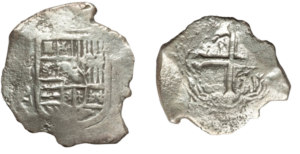
- Philip IV 4 Reales from the Concepción ship
Part of the treasure of the Concepcion, this Philip IV 4 reales coin highlights the minting quality of the Mexico Mint during the 17th century. While only half as valuable as the piece of eight, this smaller denomination played a crucial role in everyday transactions in New Spain. Considered stunning coins both then and now, these pieces typically displayed clearer strikes than their South American counterparts due to the Mexico City Mint’s superior equipment and more experienced craftsmen.
Philip IV 4 Reales
- Metal: Silver
- Year: 1622-1641
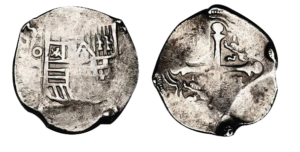
Photo by Numista
- Cartagena Mint 4 Reales Coin from the wreck of the Concepcion
This 4 reales 1641 Concepcion shipwreck coin is particularly rare, as the minting facility it was produced by only began operations in 1621. The Cartagena Mint in Colombia was established to convert South American silver into coinage closer to the source. The Concepción coins include some of the earliest known examples from this mint, making them historically significant. Under Philip IV, these coins were struck during a period when Cartagena served as a crucial Caribbean port for the Spanish treasure fleet system.
Philip IV 4 Reales
- Metal: Silver
- Year: 1627 – 1630

- Philip III 2 Reales from the Concepcion shipwreck
The Potosí 2 reales found on the Concepcion treasure ship were minted at the world’s most productive silver mint, sitting high in the Andes Mountains. During the 1630s, these coins were produced under strict quality controls implemented after the great scandal of 1617-1619, when it was discovered that coins had been debased. Assayer Juan Ximénez de Tapia oversaw production during this period, marking his coins with a distinctive “T” assayer mark. These smaller denomination coins were crucial for regional trade within the Viceroyalty of Peru and represent the reformed minting practices of the post-scandal era.
Philip III 2 Reales
- Metal: Silver
- Year: 1617-1621
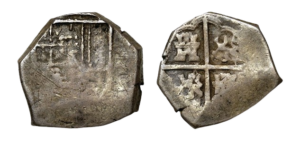
Photo by Numista
- Bolivian 8 Reales from the Nuestra señora de la Concepción shipwreck
This 8 reales coin recovered from the ship Concepcion is a testament to the Potosí Mint’s role in producing high-quality silver coins during the 17th century. These coins were minted using silver from the legendary Cerro Rico mine, known as the “mountain that eats men” due to its harsh working conditions. During Philip IV’s reign, these large silver coins showed improved quality following the mint’s reform, featuring better-centered strikes and more consistent weight than earlier issues.
Philip IV 8 Reales (Bolivia Mint)
- Metal: Silver
- Year: 1622
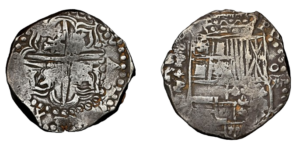
Photo by NGC
To see more exceptional specimens, beyond Concepcion coins, click here.
Where to buy rare coins
The story of the Concepción is a captivating chapter in the history of Spanish colonial maritime trade and exploration. The ship’s 1641 sinking off Hispaniola, while devastating, has left an incredible cultural legacy preserved in the thousands of coins and other artifacts recovered from the wreck site over the centuries. These numismatic treasures provide unparalleled insight into the monetary systems, trade networks, and economic realities that powered Spain’s global empire during the reigns of Philip III and Philip IV.
Those interested in acquiring rare coins, including specimens from shipwrecks, will find that Blanchard is an excellent choice. Known for its expertise in numismatics and outstanding customer service, Blanchard offers a curated selection of authentic coins of the highest quality. Blanchard’s knowledgeable team is available at all times to answer your questions about Concepcion coin value and more!
Want to read more? Subscribe to the Blanchard Newsletter and get our tales from the vault, our favorite stories from around the world and the latest tangible assets news delivered to your inbox weekly.
Gold Investors Swiftly Buy Dip to $2,500 Area
Posted on — Leave a commentPrecious metals prices soared higher in 2024, with gold and silver both showing 25%+ gains since January. After gold hit a new record high above $2,780 in late October, the precious metal slid lower, pressured by a rising U.S. dollar, profit-taking by short-term traders and on the news that U.S. presidential election would not be contested.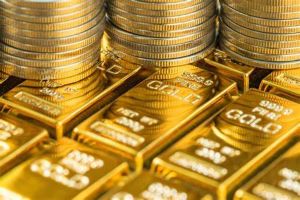
If you haven’t been watching the price of gold closely, you probably missed this latest dip in the price. This was a “don’t blink” or you might miss it type of rally in gold. During a few short days in mid-November, gold investors aggressively bought gold at the bargain price of under $2,600 an ounce.
Here’s a quick recap:
- By November 13, gold had slid as low as $2,558 an ounce.
- As gold approached support at the $2,500 an ounce area, bargain hunting gold investors quickly swooped in and began buying the yellow metal and the price began steadily climbing.
- On November 18, gold hit $2,624.
- And, by November 22, gold touched $2,717.
What does this mean for gold? The precious metal is in a strong, long-term uptrend.
The November pullback in gold was short-lived and investors used the price dip as an opportunity to accumulate precious metal at a bargain price. Some investors may be wondering if the rally in gold is coming to an end—after all, it has outpaced gains in the S&P 500 index this year.
The answer from Wall Street is a resounding no, this rally is not over! Indeed, forecasters from many banks are raising their forecasts for gold in the months ahead. So, yes indeed, this rally in gold can continue—with the next major price target at the $3,000 an ounce level. Even if you missed the recent price dip, there is still plenty of upside potential from current levels.
Here are just a few reasons that Wall Street firms project new record highs in gold to $3,000 an ounce and beyond ahead:
- The U.S. government and other advanced nations around the globe are running massive debts. Since 2016, the U.S. federal debt level has grown from 105% of GDP to 123% of GDP. And, the fiscal deficit has doubled from 3.1% in 2016 to over 6% this year. These rising and unsustainable debt levels are likely to result in higher inflation and devaluation of paper currency—which supports further upside in gold.
- Geopolitical tensions boost gold’s safe-haven appeal. From Israel’s war against Hamas to the Russian war against Ukraine, the humanitarian devastation has been high and the global military balance is fragile and unsettled. As these tensions continue to percolate, investors will continue turning to the safety of precious metals. These geopolitical tensions also raises questions about the impact to the American economy and the stability of our financial markets.
- Central banks continue to aggressively buy gold. This past July, central bank buying of gold hit a 14-year high. Major central banks like Russia, China, India, Poland, and Hungary are substantially increasing their gold reserves.
So, it’s worth repeating. Even if you missed the recent price dip, there is still plenty of upside potential from current levels in gold. As we head into year-end, take a look at your portfolio allocations and consider: is it time to buy more insurance for your wealth?
Want to read more? Subscribe to the Blanchard Newsletter and get our tales from the vault, our favorite stories from around the world and the latest tangible assets news delivered to your inbox weekly.
Measuring the Impact of Silver versus Gold in Your Portfolio
Posted on — Leave a commentMuch of the time, gold steals all the headlines and the spotlight. But, there is another precious metal in the background—that offers a less expensive entry point for accumulation—yet still offers the same portfolio diversification and risk reduction benefits. That’s silver of course.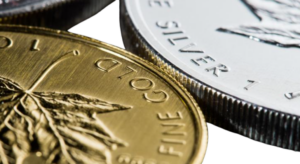
Historically, silver has proven its value during economic and geopolitical crises. In ancient and modern times, silver has acted as a store of value, an asset to preserve and grow wealth, a hedge against inflation, currency devaluation and even systemic financial instability.
Of course, both gold and silver offer investors safety during crisis periods—including the 2008 Global Financial Crisis.
“Looking back to the Great Financial Crisis which morphed into the European Debt Crisis ( the period from 2007 to 2012) silver prices rose by $40 – a 495% increase from the underlying trend. (Gold prices rose by $1100, or 238%, over the same time period,) according to The Silver Institute’s November 2024 research report.
Silver Performance during Covid
More recently, consider recent silver performance during the Covid crisis. The price of silver more than doubled as governments and central banks flooded the financial system with liquidity. Silver soared from $12.00 an ounce in March to $29.20 in August 2020.
Then, silver moved into a trading range for several years between roughly $18.00 and $26.00. Silver shot to the top of that range several times due to investor safe haven demand, notably when Russia first invaded Ukraine and then when the Silicon Valley Bank collapsed.
Earlier in 2024, silver advanced even higher on expectations for the Federal Reserve to begin reducing interest rates (which it has) and amid rising geopolitical tensions on several war fronts.
Silver vs Gold’s Performance to Geopolitical Events
In recent years, silver’s response—and price increase—to geopolitical events has been greater than gold’s reaction. Let’s look at a very geopolitical events and the impact on silver and gold with the percent change to the peak.
| Event | Date | Silver | Gold |
| Russia Invades Crimea | Jan to Dec 2014 | 14% | 13% |
| North Korea Missile Crisis | Jul to Dec 2017 | 17% | 10% |
| Iran Tensions and Attack on Saudi Oil Facilities | Jun to Dec 2019 | 25% | 12% |
| Russia Invades Ukraine | Jan 2022 to May 2022 | 17% | 13% |
| Hamas attacks Israel | Oct 2023 to Feb 2024 | 18% | 10% |
Data source: Silver Institute November 2024 report, LSEG, Reuters and Capitalight Research.
Silver Has a Dual Demand Stream
In addition to silver’s value as a monetary metal, silver is also widely used in manufacturing and industry, with new applications being discovered every day. Global silver demand is forecast to reach over 1.2 billion ounces in 2024, according to The Silver Institute. Silver is seeing increased demand from electronics, renewable energy, and the automotive sectors.
Silver as Part of Your Investment Strategy
“Integrating silver into an investment strategy not only capitalizes on its industrial utility but also leverages its historical role as a safe haven asset, ensuring a balanced and resilient portfolio,” The Silver Institute said.
Owning silver comes with the same diversification properties as gold. However, at its current price point, it is more accessible than gold at $2,670.50 an ounce. If you’ve been looking for a way to scale your exposure to the safety of precious metals, investing in silver is a cost-effective way to increase your wealth protection. Explore your options today with silver coins and bars.
Want to read more? Subscribe to the Blanchard Newsletter and get our tales from the vault, our favorite stories from around the world and the latest tangible assets news delivered to your inbox weekly.
5 Historic Shipwreck Coins from the Maravillas Treasure
Posted on — Leave a commentThe Nuestra Señora de las Maravillas sank in 1656, taking with it a magnificent trove of Spanish colonial wealth. Over centuries, the Nuestra Señora de las Maravillas shipwreck treasure has unveiled spectacular artifacts. These finds offer a vivid glimpse into the opulence of Spain’s Golden Age. Here, we will focus on the coins found among the wreck, highlighting:
- The historical significance of the pieces recovered from the Maravillas wreck
- The remarkable preservation state of many Maravillas coins
- Where collectors can acquire Maravillas treasure coins and more
Watch this story of the Nuestra Senora de las Maravillas come alive in this fascinating video:
Facts about the Maravillas treasure ship
During Spain’s colonial era, countless ships were lost to perilous seas, many loaded with immense riches bound for Spain from the Americas. Among these shipwrecks, the Maravillas stands out. These key facts help illustrate why this particular vessel continues to captivate our imagination.
Size and appearance of the Nuestra Señora de las Maravillas ship
The Maravillas ship was a two-deck galleon, built to impressive specifications in keeping with the grand naval architecture of 17th-century Spain. Measuring over 650 tons, the ship was designed to carry valuable cargo, as well as a sizable crew, armed with defenses against pirates and other threats common to the high seas.
The ship’s design followed the classic Spanish galleon configuration, featuring multiple decks organized to balance cargo with the heavy cannons that protected its bounty. It featured a distinctive high stern castle that rose dramatically above the main deck and three tall masts which dominated its profile. The mainmast, the tallest of the three, likely reached a height of over 100 feet above the waterline. Along the ship’s sides, gun ports lined the hull, housing bronze and iron cannons for protection.
As a royal galleon, Maravillas bore ornate carvings, intricate detailing, and gold embellishments, especially near the stern and the figurehead, a characteristic mark of Spain’s proud fleet during its Golden Age. The ship’s name, which translates to “Our Lady of Wonders” was likely displayed prominently on the stern.
Nuestra Senora de las Maravillas ship route
The Nuestra Señora de las Maravillas sailed as part of Spain’s famed treasure fleet, which followed a well-established and highly strategic route from the New World back to Spain. This fleet would typically depart from ports in Central or South America, such as Cartagena (Colombia) or Portobelo (Panama), loaded with precious metals and goods gathered from various Spanish colonies. These cargoes included silver, gold, and other valuables bound for Spain, vital to support the country’s wealth and power during its colonial period.
The galleons often traveled up to Havana, Cuba, a critical stop where ships would reassemble to form a convoy before making the long and dangerous journey back to Spain across the Atlantic. This route was designed to minimize the risk of pirate attacks and to navigate the complex currents and weather patterns of the Caribbean and Atlantic, though it remained perilous due to the presence of reefs, storms, and the threat of enemy ships.
On the Maravillas’ final voyage in 1656, it followed this route but met tragedy shortly after departing Havana. Near the Bahamas, a navigational error led to a collision with another ship in the convoy, causing extensive damage to the Maravillas. To make matters worse, the galleon drifted into a coral reef, further compromising its hull.
Despite desperate efforts to save the vessel, the Maravillas quickly sank, scattering its precious cargo across the seafloor and marking one of the most significant losses in Spanish maritime history.
Maravilla shipwreck location
The Maravilla shipwreck location is near Little Bahama Bank, a vast bank of coral and sand off Grand Bahama Island’s northern edge. The primary wreck site sits approximately 50 kilometers from the island, but the ship’s remains are not concentrated in a single location. Over centuries, storms and ocean currents spread the ship’s precious cargo across the ocean floor, scattering artifacts and treasure over miles.
This widespread dispersal pattern is similar to that of other famous Spanish colonial shipwrecks, such as the Nuestra Señora de Atocha coins discovery site in the Florida Keys, where treasures were found scattered across a vast underwater expanse. This widespread dispersal has made the wreck both challenging to locate and complex to explore.
Since it was first discovered in the early 1970s, the Maravillas has become one of the Bahamas’ most famous historical shipwreck sites. However, the wreck’s complex location has significant implications for salvage rights and archaeological oversight. Modern expeditions must navigate not only the physical challenges of the site but also strict regulatory requirements.
Maravillas shipwreck coins for sale
The Nuestra Señora de las Maravillas has yielded a fascinating assortment of artifacts. Among the discoveries are colonial silver reales and gold escudos, many in remarkable condition due to their preservation in the sandy, reef-protected seabed of the Little Bahama Bank.
Like the El Cazador wreck, whose silver coins helped document Spain’s monetary influence in colonial Louisiana, the Maravillas’ numismatic treasures offer crucial insights into colonial Spanish America’s economic systems. Here are five significant coins that showcase the diverse numismatic treasures recovered from this legendary shipwreck.
1. Philip IV 4 Reales from the Maravillas wreck
A silver 4 reales minted in 1655 during the reign of King Philip IV in what was then New Granada (modern-day Colombia), this cob-type coin represents the vast silver wealth that flowed through the Spanish colonial empire. Cob coins like this were hand-struck on irregular planchets, giving each piece its own unique character while maintaining the standard weight and silver content required by the Spanish Crown. Their survival after centuries underwater in the Nuestra Señora de las Maravillas shipwreck adds to their intrigue, capturing the fascination of treasure enthusiasts and history buffs alike.
Philip IV 4 Reales
- Metal: Silver
- Year: 1655
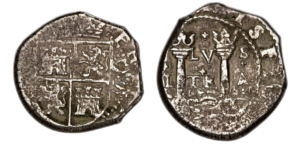
Photo by Heritage Auctions
2. Bolivian 8 Reales from the Maravillas shipwreck
Produced in Potosí, Bolivia, this 8 reales coin from the Nuestra Señora de las Maravillas wreck is significant for its historical value and distinct craftsmanship. Hand-struck in 1650, this piece represents the height of Spanish colonial silver production, with Potosí being the most important mint in the Spanish Empire.
The 8 reales was the largest silver denomination of its time, equivalent to today’s silver dollar. Collectors prize these 8 reales for their unique shape, which combined with their proven wreck provenance, makes them compelling artifacts of Spain’s colonial empire and its vast silver trade network.
Philip IV 8 Reales (Bolivia)
- Metal: Silver
- Year: 1650
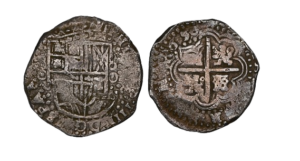
Photo by Heritage Auctions
3. Mexican 8 Reales from shipwreck Maravillas
This Mexican 8 reales coin from the Nuestra Senora de las Maravillas ship is another prized artifact of Spanish colonial history. This large silver coin, often referred to as a “piece of eight” was the primary currency of the Spanish Empire and circulated widely across Europe, Asia, and the Americas due to its consistent weight and purity.
Minted in Mexico City, one of Spain’s most significant colonial mints, renowned for processing precious metals from Mexico’s rich silver mines, these coins bear the iconic “MO” mintmark. Each coin was hand-struck, leading to subtle variations that enhance their uniqueness.
Philip IV 8 Reales (Mexico)
- Metal: Silver
- Year: 1621-1656
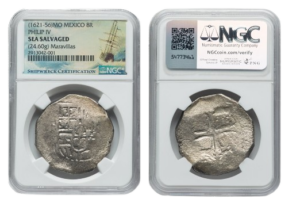
Photo by Heritage Auctions
4. A counterstamped coin from the Nuestra Señora de las Maravillas ship
The 7 1/2 reales counterstamped coin from the Nuestra Señora de las Maravillas treasure is a unique piece that highlights an unusual moment in numismatic history. Originally an 8 reales piece, this coin was officially reduced to 7 1/2 reales value through counterstamping, a common practice in the Spanish Empire to adjust currency values. The counterstamp, which often bore symbols or marks from the Spanish Crown, was applied to revalidate or alter the coin’s denomination in response to changing economic needs or as a quality assurance measure.
The Maravillas 7 1/2 reales is particularly rare, as coins with unusual denominations and counterstamps are less common, and tells a fascinating story of colonial Spanish monetary policy, speaking to its adaptability.
Philip IV Counterstamped 7-1/2 Reales
- Metal: Silver
- Year: 1651-1652
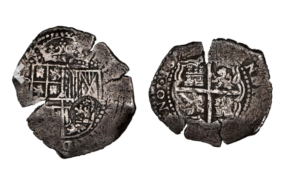
Photo by Heritage Auctions
5. 2 Escudos from the Maravillas treasure ship
This 2 Escudos coin recovered from the Maravillas shipwreck treasure found in the Bahamas represents one of the highest denominations in colonial circulation. Known as a “doubloon” and distinguished by its “R” mint mark, indicating its Colombian origin, the 2 Escudos coin was among the most prestigious coins of the Spanish colonial era.
It was primarily used for large transactions, international trade, and prestigious payments within the vast Spanish Empire. The purchasing power was significant: in the 17th century, a 2 Escudos coin could buy a fine horse or support a family for several months.
Philip IV 2 Escudos
- Metal: Gold
- Year: 1627-1629
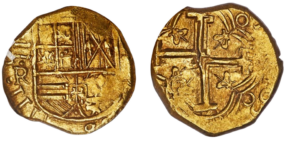
Photo by Heritage Auctions
To browse more rare coins, beyond the Maravillas shipwreck treasure, click here.
Where to buy rare coins
The Nuestra Señora de las Maravillas represents far more than just another Spanish shipwreck discovery. Its diverse cargo of colonial coinage provides crucial documentation of Spain’s complex monetary system and trade routes. The exceptional preservation of many Maravillas coins, protected by the Bahamas’ sandy banks, offers collectors specimens that surpass typical shipwreck yields in both condition and historical significance.
If these treasures inspire your interest in rare coins and historical artifacts, consider buying from Blanchard. As a trusted leader in numismatics, Blanchard offers unparalleled expertise and a curated selection of coins that capture the stories of the past. Whether you’re a seasoned collector or just beginning your journey, Blanchard’s knowledgeable team is ready to help you find exceptional pieces that enrich your collection. Contact Blanchard today for Maravillas shipwreck coins for sale and more.
Want to read more? Subscribe to the Blanchard Newsletter and get our tales from the vault, our favorite stories from around the world and the latest tangible assets news delivered to your inbox weekly.
5 Questions and Answers about Collecting Mercury Dimes
Posted on — Leave a commentThere’s a reason that collectors—even beginning numismatists—go after the satisfying goal of sourcing and owning an iconic Mercury Dime set—it’s fairly easy to complete. The cost can range from about $2,500 up to nearly $850,000, depending on your budget, your goals and the grades you choose.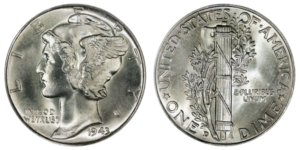
Q. Why should you consider building a set of Mercury dimes?
A. It’s exciting and can be profitable too. Many collections of rare coin sets have sold as a whole for more than the total value of the individual coins.
Q. How do you build a set?
A. Coin investors typically follow one of two sets: “type” and “series.” A type set is comprised of all of those coins sharing a single specific characteristic such as a design, designer or denomination. A series include one coin from each date and mint of a particular type.
Other coin collecting strategies include collecting by mint mark, by individual year, or first and last year of the issue of a coin.
Q. What is the Mercury Dime?
A. The Winged Liberty Head Dime, popularly known as the “Mercury” Dime was struck from 1916 until 1945. Renowned sculptor Adolph A. Weinman designed this highly sought after coin. Even during its years of production, collectors clamored to own these coins for their collections.
As a coin group, Mercury dimes aren’t rare. A whopping 2.5 billion were struck from 1916 through 1945. Mercury dimes were last struck in 1945, when a new dime was created to feature Franklin D. Roosevelt, following his passing.
During the depths of the Great Depression, no dimes were struck from 1932-1933. Today, rare coin collectors classify Mercury Dimes into “early dates” (1916-1931) and “late dates” (1934-1945) categories. Nearly all late dates are common and can be easily acquired.
The Mercury dime is struck with 90 percent silver and 10 percent copper and the coin contains just over .072 troy ounces of silver.
Q. Why do we call it the Mercury dime?
A. Early on, the public was a bit confused about the obverse design. Lady Liberty is wearing a winged helmet which led to comparisons between her and the Roman god, Mercury. Because of this, the moniker “Mercury Dime” stuck.
This cap was intended to represent the “Liberty of Thought.” Weinman’s monogram, “AW”, sits on the right of the Liberty’s neck. The reverse features an intriguing design: a fasces depicting unity and strength, and an olive branch symbolizing peace.
The metal content is 90% silver and 10% copper. The mints include Philadelphia, Denver and San Francisco.
Q. What are some of the interesting and hard to find Mercury dimes?
A. Within the Mercury Dime series, there are only a few absolute rarities and there is only one that is hard to find.
The 1916-D is the scarcest major key date and rarity within the Mercury Dime series. Only 264,000 were struck. You may be wondering why the 1916-D Mercury Dimes had such a low mintage of only 264,000. Good question! Production of this coin was halted after the U.S. Treasury department entered an urgent order late in the year for 4 million quarter dollars.
Advanced collectors strive to acquire a 1916-D Mercury dimes for their collections in part to its low mintage and also because of their unique status as first ‘year-of-issue’ type coins. Some type collectors only acquire first-year coins.
Other Mercury dime key dates include 1921 and 1921-D and 1942-1 and 1942 -1D. The latter key dates show “overdates” with the number “2” struck over the number “1.”
Another interesting “error” coins involved a 1943 Mercury dime. The 1943 Lincoln penny struck over a struck 1943 Mercury dime is a remarkable and rare double denomination error coin and is one collectors avidly seek. How did this happen? This error coin was created when a dime was mistakenly fed into a printing press coining cents. This highly sought after error coin combines the three-pronged popularity of the Lincoln cent, the Mercury dime and its 1943 date, caused by the desirability of the famous 1943 copper cents.
If you are interested in building a Mercury dime set or are looking for that one hard to find coin to complete your set—call Blanchard today—we’re here to help.
Want to read more? Subscribe to the Blanchard Newsletter and get our tales from the vault, our favorite stories from around the world and the latest tangible assets news delivered to your inbox weekly.
D. Brent Pogue Collection: One of the Most Valuable in Numismatic History
Posted on — Leave a commentIn 1974 in Dallas, a successful real estate developer named Mack Pogue brought home a gift for his 10-year-old son Brent—a bag of Lincoln wheat pennies.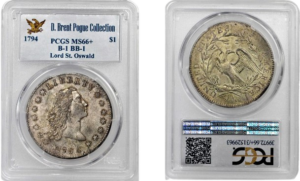
Mack had bought the bag of coins from his brother Jack for $100 and wanted to encourage an entrepreneurial spirit in his son. So, he gave his son Brent an “option” to buy the bag of pennies from him for $110 within one week.
Brent dutifully took the bag along with a copy of the coin Guide Book and began examining the pennies one by one. He soon came upon a shiny 1915 cent that looked bright as new. Brent discovered in the Guide Book that it was worth $65!
“I was immediately hooked,” Brent said later.
That also opened the door to his interest in exploring American and numismatic history. “My first thought, since there was no mintmark, was ‘How did this penny make it from Philadelphia to Dallas? Then I asked myself ‘who was the president of the United States in 1915? What else was happening that year?’” Brent said.
He quickly told his father that he would “exercise his option” and purchased the bag of pennies. From there, the rest is numismatic history as a true genius followed his passion.
Over the next 35 years Brent Pogue amassed an extraordinary collection of over 650 early American federal coins from 1792 to the late 1830’s era in the best available condition. Simply put, numismatists believed his collection was the finest-ever. Brent himself described it as “a collection representing our country’s economic birth.”
Brent became a student of numismatic history, conducting in-depth research about each U.S. coin series in an effort to absorb as much knowledge as possible. Brent moved far beyond the Guide Book in his research efforts and built an extensive reference library of numismatic books and catalogues to support his ongoing education.
Outside of coins, Brent followed in his father’s footsteps and made a career in real estate. He used many of his finely tuned negotiation and entrepreneurial skills from the business world in his numismatic pursuits.
“You have to be opportunistic, and you have to have guts,” Brent said. At one auction Brent bid $4.1 million on the legendary 1804 silver dollar—in the finest condition of eight known. At that time, that amount was twice as much as had ever been paid for any coin at auction.
While Pogue passed in 2019, his collection lives on in the numismatic world today. Through a series of sales that began in 2015, his collection of high caliber, rare U.S. coins has fetched over $140 million.
The extensive and impressive Pogue collection included an excellent selection of early American coins from half dimes to quarter eagles to half eagles to three-dollar gold pieces to silver dollars to large cents and even early American paper money. The sheer size and scope along with the high-quality of the Pogue collection is unmatched in numismatic history.
A renowned numismatist said at the time of his death that “Brent was the very definition of an extraordinary numismatist, a connoisseur. A careful student with a fine library at hand, he researched every coin he hoped to add to his collection.”
Want to read more? Subscribe to the Blanchard Newsletter and get our tales from the vault, our favorite stories from around the world and the latest tangible assets news delivered to your inbox weekly.
U.S. Treasury Bonds or Gold: Which Are Safer
Posted on — Leave a commentU.S. Treasury bonds have long been seen as the gold standard for safety. In times of financial crisis, war and recessions, investors around the globe turned to the perceived safety of U.S. Treasury debt.
the perceived safety of U.S. Treasury debt.
After all, Treasuries are backed by the full faith and credit of the United States federal government.
Simply put, our government has promised to pay back lenders with interest.
Yet times are changing.
Analysts at Bank of America recently raised this question—U.S. Treasury bonds or gold: which are safer—in a research note to clients.
It’s a fair question.
The U.S. national debt is soaring. There is zero focus or political will on debt reduction. The many tax cuts that have been recently proposed are only expected to increase our debt in the years ahead. There is no relief in sight for our federal debt.
So, where do we stand now and what does this mean for investors?
The U.S. national debt currently stands at $35.8 trillion and as a percentage of our gross domestic product is nearly 125%.
What’s more, our nation’s policymakers have been willing to gamble with the full faith and credit of our nation’s word that we will pay back our debt. When people or institutions lend money, they want confidence that they will get their money back.
Investors with long memories will remember the dog days of August 2011. That’s when Congress held the debt ceiling hostage in a full blown fight over raising the debt limit—and our elected officials took our nation to the brink of defaulting on our debt.
What happened then? Gold soared to its then all-time high above $1,900. Global investors turned to gold as a safe haven. Standard & Poor’s downgraded the U.S. credit rating. And, the stock market tanked.
The key thing with debt is that you have to pay it back. Otherwise, people, countries, corporations around the globe who buy Treasury debt aren’t very willing to do it in the future. Or, if they are willing to risk their investment, they will demand higher interest rates to lend their money.
Are we at a watershed moment when investors are realizing that gold is safer that U.S. Treasury debt? Could be.
Gold broke through the $2,700 an ounce barrier for the first time ever recently. The number of firms that now project gold gains to $3,000 an ounce are too many to count.
Gold’s role as currency and as an asset to protect, preserve and grow your wealth has lasted for centuries and shows no signs of losing its appeal.
As the national debt keeps rising, that means the Treasury will need to issue more and more bonds. However, there are real questions about whether investors will keep buying them at the pace the Treasury needs to sell them.
So, what did Bank of America analysts say about this question?
“Rising funding needs, debt servicing costs, and concerns over the sustainability of fiscal policy may well mean that gold prices could increase, if rates move up.”
Here’s what Bank of America concluded:
“Indeed, with lingering concerns over U.S. funding needs and their impact on the U.S. Treasury market, the yellow metal may become the ultimate perceived safe haven asset,” the analysts said. “Ultimately, something has to give: If markets become reluctant to absorb all the debt and volatility increases, gold may be the last perceived safe haven asset standing.”
Here’s what we say:
Want to read more? Subscribe to the Blanchard Newsletter and get our tales from the vault, our favorite stories from around the world and the latest tangible assets news delivered to your inbox weekly.
Fed cuts rates, gold bounces higher after election dip
Posted on — Leave a commentFed Cuts Interest Rates for Second Time in 2024 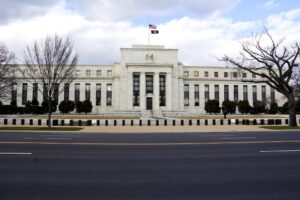
As expected, the Federal Reserve delivered its second interest rate cut of 2024 on Thursday. The central bankers updated their policy statement saying: “The Committee judges that the risks to achieving its employment and inflation goals are roughly in balance.” The Fed cut its key interest rate by 0.25 percentage points to 4.50-4.75%.
How did markets react? Gold traded $32.50 higher Thursday afternoon at $2,703.30. Silver also traded higher on the day, up .74 at $32.03. The stock market generally rose in lackluster trading, Treasury yields fell, and the U.S. dollar slid lower.
What about the election? Reporters asked Federal Reserve Chair Jerome Powell about the elephant in the room: will Donald Trump’s election victory shape future Fed decisions? At the post-meeting press conference, Fed Chair Powell pushed back on those ideas.
Powell said the election will have “no effect” on the Fed’s policy decisions near term. “Many things affect the economy,” Powell told reporters. “We don’t guess, speculate or assume” what the potential economic impact of what the next administration could be.
What could lie ahead? On Thursday, the central bankers were essentially following through on the interest rate cut they signaled at their September meeting. But economists are warning the future interest rate cuts may not be as speedy or deep as previously expected. Some of President-elect Trump’s policies like rising tariffs could potentially reignite inflation. According to a recent Barron’s Big Money Poll, the resurgence of inflation was the number one risk over the next six months.
Recent economic reports have shown red flags. The October jobs report revealed only 12,000 new jobs last month, well below expectations for 105,000 jobs created. The most recent inflation data shows higher prices are still sticking around – especially when you factor in food and gas. The Fed’s preferred inflation gauge, the personal consumption expenditure (PCE) rate, revealed a 2.7% annual increase in September.
What does this mean for gold? Investors swiftly bought the election dip in gold and precious metals are climbing on Thursday afternoon. Gold and silver are turning out double-digit gains in 2024 as investors turn to the safety and security of precious metals. With new questions on the horizon about the potential resurgence on inflation, gold will continue to have the wind at its back.
Gold broke through the $2,700 an ounce barrier to a new record high for the first time ever recently. The number of firms that now project gold gains to $3,000 an ounce are too many to count.
Gold’s role as currency and an asset to protect, preserve and grow your wealth has lasted for centuries and shows no signs of losing its appeal. If you have been thinking about increasing your allocation to gold, there’s never been a better time. It’s easy to increase your wealth protection, why not do it today?
Want to read more? Subscribe to the Blanchard Newsletter and get our tales from the vault, our favorite stories from around the world and the latest tangible assets news delivered to your inbox weekly.








